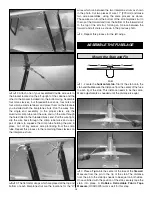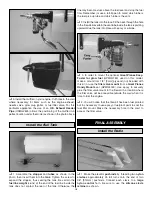
❏
3. Make certain that the control surfaces and the
carburetor respond in the correct direction as shown in the
diagram. If any of the controls respond in the wrong direction,
use the
servo reversing
in the transmitter to reverse the
servos connected to those controls. Be certain the control
surfaces have remained centered. Adjust if necessary.
Use a
Great Planes AccuThrow Deflection Gauge
(GPMR2405) or a ruler to accurately measure and set the
control throw of each control surface as indicated in the
chart that follows. If your radio does not have dual rates, we
recommend setting the throws at the
low
rate setting.
NOTE:
The throws are measured at the
widest part
of the
elevators, rudder and ailerons.
At this stage the model should be in ready-to-fly condition
with all of the systems in place including the engine, landing
gear, covering and paint and the radio system.
❏
1. Use a felt-tip pen or 1/8” [3mm]-wide tape to accurately
mark the C.G. on the
top
of the
bottom wing
next to both
sides of the fuselage. Start from the forward-most point of
the leading edge (not the cut-out area), and measure back
2-3/4”
[70mm]. See the sketch on page 22.
This is where your model should balance for your first
flights. Later, you may wish to experiment by shifting the
C.G. up to 2-1/2" [64mm] back from the leading edge or 3"
[76mm] back from the leading edge to change the flying
characteristics. Moving the C.G. forward may improve the
smoothness and stability, but it may then require more
speed for takeoff and make it more difficult to slow for
landing. Moving the C.G. aft makes the model more
maneuverable, but could also cause it to become too
difficult for you to control. In any case, start at the location
we recommend and do not at any time balance your
model outside the recommended range.
More than any other factor, the
C.G.
(balance point) can
have the
greatest
effect on how a model flies and may
determine whether or not your first flight will be
successful. If you value this model and wish to enjoy it for
many flights,
DO NOT OVERLOOK THIS IMPORTANT
PROCEDURE.
A model that is not properly balanced will
be unstable and possibly unflyable.
Balance the Model (C.G.)
IMPORTANT:
The Tiger Moth has been
extensively
flown
and tested to arrive at the throws at which it flies best.
Flying your model at these throws will provide you with the
greatest chance for successful first flights. If, after you
have become accustomed to the way the Tiger Moth flies,
you would like to change the throws to suit your taste, that
is fine. However, too much control throw could make the
model difficult to control, so remember, “more is not
always better.”
These are the recommend control surface throws:
High Rate
Low Rate
ELEVATOR:
1" [25.4mm] up
3/4" [19.1mm] up
1" [25.4mm] down
3/4" [19.1mm] down
RUDDER:
2" [50.8mm] right
2" [50.8mm] right
2" [50.8mm] left
2" [50.8mm] left
AILERONS:
3/4" [19.1mm] up
1/2" [12.7mm] up
3/4" [19.1mm] down
1/2" [12.7mm] down
Set the Control Throws
CARBURETOR WIDE OPEN
RUDDER MOVES RIGHT
LEFT AILERON MOVES DOWN
RIGHT AILERON MOVES UP
ELEVATOR MOVES UP
4-CHANNEL
TRANSMITTER
(STANDARD MODE 2)
4-CHANNEL RADIO SETUP
TRANSMITTER
4-CHANNEL
TRANSMITTER
4-CHANNEL
TRANSMITTER
4-CHANNEL
21








































